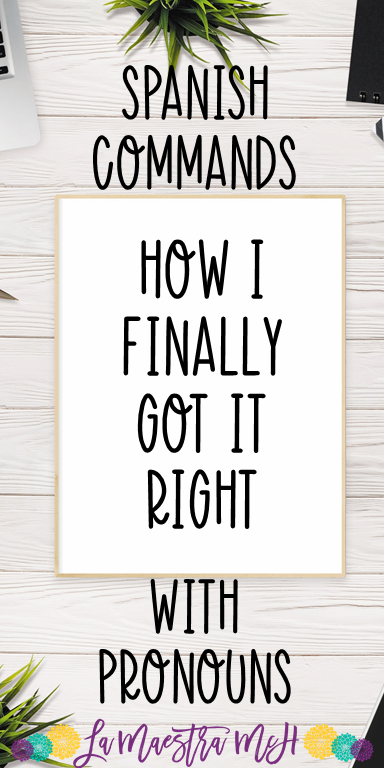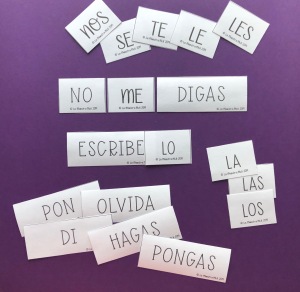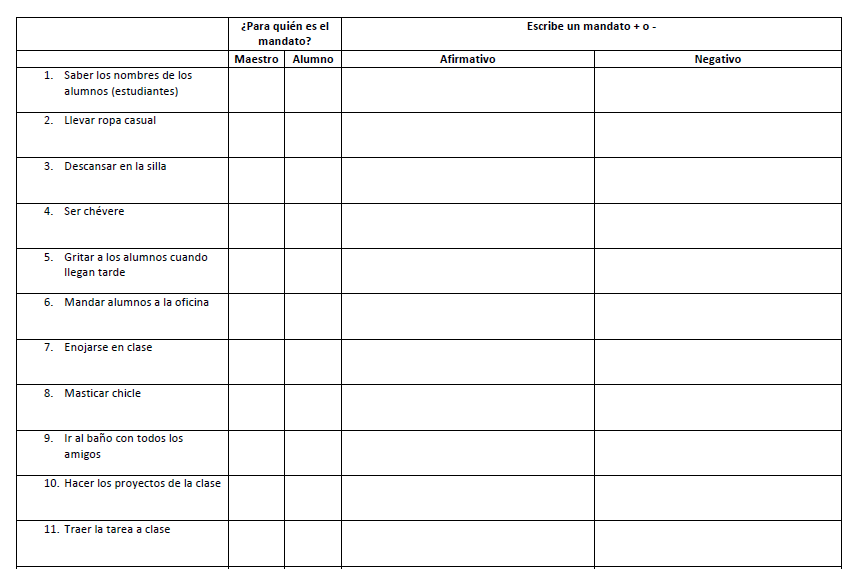Commands With Pronouns: How I Finally Got it Right
Do you ever have those moments when you are SURE your lesson is going to go great? You KNOW students are going to remember past skills, understand this next step, and it’s all going to be a breeze? Then, it all comes crashing down into a hot dumpster fire of stinky diapers?
Yeah, me too.
I had one of those days recently. My foe: Spanish commands with pronouns. I won’t bore you with what went wrong. I’ll skip right to how I fixed it AND hook you up with some FREE materials & ideas for teaching Spanish commands with pronouns.

I love Spanish commands with pronouns. Not only do students need to remember what the pronouns are but there are so many fun quirks:
-pronoun order
-pronoun placement
-adding accents to positive commands
-“le lo” > “se lo” or “les las” > “se las”, etc
Step 1: Review pronouns.
Direct & Indirect Object Pronouns: Enter Señor Wooly’s, “No lo tengo”. I modified embedded readings (available with a pro subscription) and made a short activity where students circle the item the girl is missing and then circle the direct object pronoun in the sentence, “Ella no ____ tiene” and draw a line connecting this. It also offers examples of “le dice,” “les respondió,” They then translated sentences. Done!

Reflexive Pronouns: Good old fashioned charades, kind of. I project a command on my wall (lávate las manos, cepíllate el pelo, ponte los zapatos, no te sientes) and the first team to act it out correctly gets a point.
Step 2: Where to put pronouns with commands and in what order.
Placement: “In life, attach yourself to positive things and stay in front of the negative things.” I tell students this quote as a memory aide and after they see enough examples, placement really isn’t an issue.
Order: I was taught the rhyme, “Indirect, direct, reflexive always first”. Ok, so it doesn’t rhyme but when you say it with the right rhythm, it’s catchy. I also told them “RID,” “Reflexive, Indirect, Direct”.
Step 3: Accents
I decided not to focus TOO much on this. As students kept seeing examples of commands with pronouns attached, they began to figure it out. I’ve decided I can relax on this point, for now. As time the year goes on, I’m confident they’ll sort it out after enough input.
Written Commands with Pronouns Practice
I had students start with a stair-step style worksheet. (You can get a free copy here!) We did a few as a class before letting them do it on their own/with a partner. Breaking commands with pronouns down into more manageable chunks made it less intimidating.
Hands-on Commands with Pronouns Activity

Next, I used these hands-on cards with a slide show of English & Spanish commands. I projected the English commands. Students formed the command with pronouns using their cards. I walked around and offered helpful reminders about pronoun placement or vocab. When students were done making their commands, I projected the correct answer and fielded any questions. As we moved through the commands, the students caught on to the “se lo” spelling changes and became more confident in the placement and order of the pronouns with commands. Many students even said that the activity helped them. Like, they actually said it, out loud, to me!
Situations & Advice
The next class we used the same cards as above with a twist (I’m all about getting more use out of one resource!). I began to tell students situations I was in and asked for their advice in the form of a Spanish command with pronouns. For example,
You guys, this morning I heard a rumor. A bad rumor. About Mr. H (our principal). Should I tell him or not?
I wrote the word for rumor on the board since students didn’t know it and then wrote the sentence scaffold, “¿Debo yo ________?” This allowed me to provide support by telling them the verb to use, decir in the example above. Students could then form any of the following commands with pronouns, dilo, díselo, dile, no lo digas, no se lo digas, no le digas. It was fun to follow up and laugh about who the “honest” students were in this case. Other situations I used:
- I have a pet cow AND I love hamburgers. Should I eat my pet?
- Should I get this awful drawing (which I drew on the board) as a tattoo?
- My friend wants to copy my homework. She’s really stressed. Should I give it to her?
- Should I put my Christmas tree up in October?
In one class we had time for students to come up with their own situation and ask advice from their classmates, which was so fun! This would be a fun extension activity to pursue further.
Commands with Pronouns Worksheet & Other Practice Opportunities

Sprinkled in among these activities were two work book style activities for concrete, individual practice students could do. I also had them match commands with pronouns to their favorite Señor Wooly characters (e.g. Sé amable con Gorro, for Billy from Billy y las botas 1). Each daily warm up offered some review questions about the pronouns and some opportunities to create commands. In class, students previewed the vocab for Señor Wooly’s “Sé Chévere“, and created commands with this document. Make yourself a copy if you’d like. For homework, after watching, they created Spanish commands with pronouns for a new teacher.
Next week they’ll be taking a quiz over commands with pronouns on which they’ll offer up some advice in response to situations I present them. As well as translating some commands for teachers and students.
Do you have any tips for teaching Spanish commands with pronouns or any double object pronoun practice? I’d love to hear it below!
And if you want to get a your own copy of the hands-on activity, click here!



2 Comments